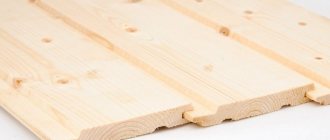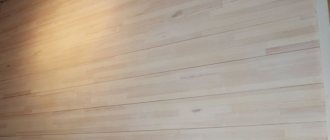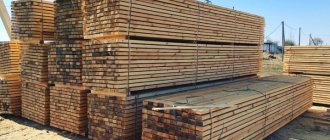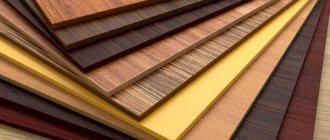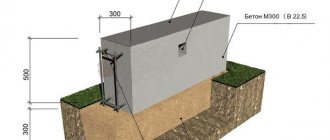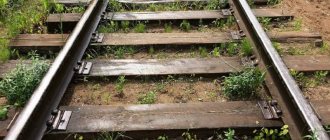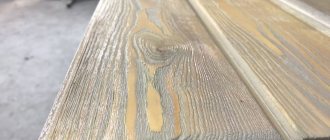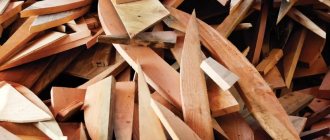The lining is so familiar and pleasing to the eye that every Russian man, like a gentleman who “remembers the date, but forgets about the age,” can close his eyes and easily remember its darling to the last knot and burr, but will definitely forget the dimensions. Save this article to your browser bookmarks so that the tables are always at hand.
Do you know?
GOSTs do not have such a term as “lining”. Official documents use the term “cladding” or “cladding board”. And the common and more familiar name for us, lining, comes from railway cars with sheathing made of individual boards tightly adjacent to each other. Material with this type of connection was liked by craftsmen and therefore today is used for exterior and interior decoration everywhere.
Currently, the production of this finishing material is regulated by the following standards: Russian standard GOST 8242-88 and German standard DIN 68-126/86, TU. The latter places more stringent requirements on quality and grade.
How to decipher the manufacturer's inscription
We read the marking as follows:
- Sheathing brand (see details below)
- Type of lining (see table below)
- ThicknessxWidthxLength
- GOST
- Sometimes manufacturers indicate the number of pieces per package
An example of a symbol for eurolining:
Grade C 12.5×96(88)x2000 mm 10 pcs. in unitary enterprise
Eurolining grade C, 12.5 mm thick, 96 mm thick, 2000 mm long. Pack of 10 pcs. An example of a regular lining according to GOST:
O-3-13x120x4000-GOST 8242-88 This means - Sheathing grade O-3 13 mm thick, 120 mm wide, 4000 mm long, manufactured in accordance with GOST 8242-88.
GOST and DIN: what is it, how do they differ
Modern production of lining is strictly regulated by two standards: GOST and DIN.
The first is the domestic standard of quality, the second is German. The panels are sorted before being sold. The domestic manufacturer offers three grades: 1, 2, 3, where 1 is the highest, 3 is the lowest. According to the European standard, varieties Extra, A, B, C are distinguished.
Extra features a perfectly flat and smooth surface without knots, cracks, or flaws. The color of the panels is uniform, without differences. Further, depending on the number of defects, the quality of the lining becomes lower.
Dimensions of standard lining according to GOST
Classic lining, popularly known as “collective farmer”, is regulated by GOSTs with the name “cladding board” of the following sizes and sections:
Brand O-1
Markai O-2 (1st option)
Brand O-2 (2nd option)
Brand O-3 (1st option)
Brand O-3 (2nd option)
Brand O-4
It is made from various types of wood: pine, spruce (conifers are the cheapest), birch, alder, linden, aspen, ash, oak, larch, cedar.
Evolution has taken the dimensions of cladding boards beyond the limits established by state standards and today you can easily find products for sale in the following sizes: thickness from 12 to 25 mm; width—up to 150 mm; length - up to 6000 mm.
Video description
This video shows how to choose a cladding board:
American lining
This type of facade board is also called herringbone siding. This type of cladding is suitable for cladding building facades.
The American one is made of natural wood, metal, and plastic. “Herringbone” has a protective coating that allows you to use the material without painting.
American lining Source 1povagonke.ru
Double sided board
This facing does not have a reverse side. Double-sided boards are not used in rooms with high humidity. Panel materials of this type are used for decorative purposes.
"Calm"
The peculiarity of this type of finishing material is the absence of a chamfer and a thickness of 25 mm. “Calm” lining is used where it is necessary to create a surface that imitates timber. The length and working width of the lining depends on the model and brand. The board is used for cladding the facades of buildings.
Calm board Source lessibir.ru
Dimensions of eurolining
Manufactured according to Western European standard DIN 68126/86. The key difference from the domestic standard version discussed above is the presence of longitudinal ventilation grooves (see photo below this paragraph) on the reverse side, which work as stress compensators arising from changes in temperature and humidity, and also facilitate the removal of condensate due to air circulation.
Dimensions according to European standards: Thickness – 12.5-14-16-19-21 mm; Width – 80-100-110-120-138 mm; The thickness of the lining is calm for internal use - 12.5–16 mm, for external use - 18.5–22.5 mm. Length gradation at the discretion of the manufacturer. Packaged in packs of 10 pcs.
Product Information
If you do the work yourself, then you will have to choose the material yourself. Therefore, carefully read the information from the sections below and use it when purchasing lining.
This is what a linden tree looks like in its natural environment
The wood itself has a fairly soft structure, which makes it easy to process. And the wide distribution of this species in our flora reduces the cost. When making linden lining, trees under 50 years old are used. Due to this, the number of knots on future boards is reduced to a minimum.
Production of linden lining
MDF lining
This type of lining is produced by pressing wood chips at high temperatures.
| Manufacturer | Length, cm | Width, mm | Thickness, mm |
| Kronospan | 260 | 200 | 14 |
| 260 | 325 | 9 | |
| 260 | 153 | 8 | |
| 260 | 200 | 7 | |
| 260 | 153 | 7 | |
| NDM | 130 | 198 | 6 |
| 260 | 198 | 6 | |
| Union | 260 | 238 | 7 |
Installation principles
First you need to take measurements of the room that will be processed. This will allow you to calculate the required amount of material, as well as the optimal overall dimensions of the eurolining: current length, width and thickness.
Next you need to take care of creating the frame. The lathing for eurolining is created from wooden blocks. In some cases, it is relevant to use U-shaped suspensions when installing a ceiling.
Considering the chosen installation method, the frame should be fixed perpendicular to the direction of the finishing panels. The distance between the bars is regulated at half a meter. The sheathing is secured using screws and dowels. Insulation should be placed in the sections.
Wooden lining is mounted on clamps if its thickness is less than 16 mm. The length of the lining is joined very simply: they are installed as close to each other as possible, and then the joint is closed with a strip.
In some cases, for example, when finishing balconies or loggias, it makes sense to use insulation. This will significantly increase the temperature inside the room and will provide good thermal insulation.
As a rule, eurolining is installed vertically, as shown in the photo. This visually increases the height of the ceilings and the free space of the room. Installation diagonally is also possible, but you just have to be prepared for the fact that a large amount of material will be consumed.
Laying should begin from the corner. In the process you need to use a level and a wooden hammer. The eurolining must be secured in such a way that all fasteners are hidden from human view.
Recommendation: you need to be especially vigilant with eurolining made of larch, because, despite its strength, it is easily damaged during installation.
Processing - finish
Additional surface treatment may be required at the end. By the way, if eurolining is used in special conditions, its treatment with special compounds is recommended even before installation. The finishing layer can be paint or varnish, which will give the surface a finished look and become reliable protection against external influences of various types, while creating the desired visual effect.
How many linings are there in a cube? Calculation method using the 5th grade mathematics formula
From my own experience, I can say that for domestic needs, 1 m3 of lining is enough for about 75-80 m2; taking into account the cuts, it will be possible to cover about 70 m2 of “usable area”. Naturally, this dimensional guideline is very approximate and I recommend that you perform the necessary calculations yourself, taking into account your individual task.
Now you will see that it is very easy. Any search engine will kindly remind you of the formula for the volume of a rectangular parallelepiped from 5th grade mathematics:
Let our lining have dimensions: Width
85 mm , Thickness 18 mm , Length 3 m
. We calculate the volume of one board V1 = 0.018 m*0.085 m*3 m=0.00459 m3 Quantity in one cube, pcs N= 1/0.00459 = 218 pcs
Attention: In the calculations we use the “useful” width of the lining, without taking into account the size of the tongue-and-groove connection, as the lining boards will be packed end-to-end.
To calculate the area that we can cover with 1 m3 of lining, we calculate the area of one board S1 = 0.085 m * 3 m = 0.255 m2 Take the number of boards calculated above and multiply by the area of one board S = 218 pcs * 0.255 m2 = 56 m2
Subtract 10% for trimmings: 56 m2-6 m2 = 50 m2
In total, 1 cube of board measuring 85*18*3000 mm is enough to cover a wall with an area of 50 m2 .
Types of finishes
Swiss chalet
This design style is best used in a suburban area with a home of any size. We will need a wide lining 6 meters long to decorate the roof. A sloping roof with large angles of inclination and a visor is the central part of the exterior. This element not only creates the feeling of a house in the Alps, but also serves to protect the room from negative environmental factors.
Traditionally, a Swiss chalet has 2 floors with a balcony, or it can be a one-story building with an open terrace.
Inside the house, the interior is also made using lining of various lengths. The walls and ceiling are sheathed using lumber.
Provence One of the most popular interior styles, used both in private homes and city apartments. Coffee shops and small restaurants often prefer this design. The use of living textured material - lining in large quantities - is the basic principle of constructing the Provence style. Lumber, as a rule, is painted in light pastel shades - olive, pale pink, soft lilac. Lightness, a feeling of comfort and homeliness, the absence of unnecessary decor and furniture - true Provence style.
Country This type of design direction is most often used for one space in a living room: living room, kitchen or bedroom. The main goal is to create a rustic, sophisticated style.
Simplicity, but with moderate gloss, comfortable furniture, but without modern trends, and necessarily finishing the walls with high-quality lining (it is advisable to use the highest grades and lumber from expensive tree species).
The interior styles given as examples are far from the only ones. With the help of lining of various lengths, you can make your dream of comfortable, cozy housing come true for any financial opportunity.
Peculiarities
Lining is a milled, most often wooden board, which is widely used in the construction and decoration of various domestic premises. This is not a recycled product, but a solid wood material, specially processed for easy assembly when covering walls, ceilings and other components of housing and utility rooms. The lining material does not contain harmful impurities, with the exception of agents against rotting and the action of wood parasites
All finished products in the form of lining must meet the requirements of standards adopted in the EU and Russia.
Main dimensions according to EU standards:
- thickness;
- width (usable);
- length;
- spike size.
The starting material for the production of this type of product is coniferous trees (pine, spruce, larch), as the cheapest and most accessible for processing and use. But hardwood is often used for expensive cladding.
It must be remembered that coniferous species, especially spruce and pine, release resin when heated strongly, so for lining baths you should combine different species to avoid unpleasant sensations.
For cladding bathhouses and bathhouses, a whole range of tree species are used from which lining can be made. Linden occupies a special place here. Its versatile and healing properties make it an ideal bath option.
Essential oils released from linden when heated have many medicinal properties, including anti-inflammatory and antibacterial. Staying in a steam room decorated with linden eliminates colds. In addition, linden resists moisture and maintains a sanded surface for a long time.
Depending on the purpose, shape, cross-section, relief, and methods of assembling the lining, there can be different options that have already been used for many years in construction practice. There are also new forms offered by designers and developers of building and finishing materials. Different types of wood are used in different ways.
Larch is the most durable wood material , which ranks top in popularity among those who live in houses decorated with wood.
In areas near country houses, the walls of houses, entrances, gazebos, and verandas are covered with larch cladding. A larch porch can decorate a house of any size. There is no doubt about the environmental friendliness of this type of wood. When covering the external surfaces with material, the attractiveness of the house only increases. Moreover, the external and strength characteristics of larch cladding are preserved for many years.
An excellent finishing material is alder. Like linden, it has medicinal properties, is perfectly polished, and retains its external characteristics for many years. The tree is not afraid of moisture, upon contact it gives a feeling of warmth, so sitting on the alder trim in the bathhouse will be very pleasant.
Wall cladding creates an atmosphere of coziness and comfort. Each type of wood used for the production of lining boards has its own characteristics. The beautiful clapboard finishing of the house both inside and outside gives the home a unique design.
Where is it used?
When manufacturing the first passenger cars, due to the low traction characteristics of steam locomotives of that time, it was necessary that the weight of the train correspond to these capacities. Then it was proposed to make the lining of the cars from boards of a special shape, which ensured a certain tightness of the cars. Hence the name “Vagonka”.
Various rooms are sheathed or decorated with lining. This is a material for interior cladding of walls of rooms, terraces, balconies, loggias, baths, dressing rooms, verandas. Houses with blockhouse and American exterior cladding look good. The need for lining in country house construction and the private sector, finishing of apartments and office premises is growing. Every year the number of proposed new forms and profiles of lining boards increases.
No. 4. Which wood is better?
In fact, any wood can be used to make lining, but the properties of the lining will differ greatly, as will its price. Cheaper lining is not always worse, since the material should be chosen based on its operating conditions. As for the color of wood, its choice is a purely subjective opinion.
All lining that is present on the modern market can be divided into two main types:
- lining made of softwood;
- lining made of hardwood.
Coniferous wood has a high content of resins and essential oils, due to which it resists the formation of fungus and withstands high humidity. This material has found a wide range of applications; it is excellent for external cladding, but is completely unsuitable for saunas and baths. Under the influence of high temperatures, resin begins to release, and this process can continue for a long time. Not only does the material become sticky, but it can also spontaneously ignite. However, spruce and pine wood is used in Northern European countries to construct saunas, but the material is de-resined.
Most often, the following coniferous species are used to make lining:
- pine . It has a nice design, high strength, is inexpensive, but from time to time it needs to be varnished so that the material does not begin to darken;
- spruce _ Wood has excellent thermal insulation properties and a pleasant shade;
- larch . It is very resistant to external influences, does not warp even with significant temperature fluctuations, and is resistant to pests;
- cedar _ Expensive wood with excellent performance properties, color from yellowish to coffee.
Hardwoods are less durable, but do not emit resins and do not heat up well, which allows them to be used in baths and saunas. They require regular treatment, otherwise under the influence of external factors they will change color and deteriorate. The most popular hardwoods:
- oak _ The most durable and strong, resistant to rotting, dense, with a beautiful wood pattern, but such material also costs quite a lot;
- Linden . Wood has excellent soundproofing qualities and a subtle pleasant aroma; it is often used for finishing baths;
- ash _ Due to its high hardness, such wood does not crack at all. Color – dark yellow;
- black alder has a pleasant light coffee color and is resistant to moisture.
Separately, it is worth noting that only low-density wood is suitable for a bathhouse, otherwise the material will become very hot, which can result in burns.
